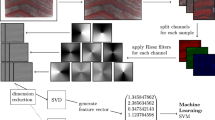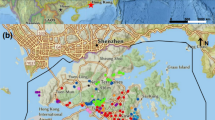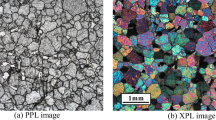Abstract
Conventional convolutional neural networks (CNN) are deficient in the rock type recognition due to large convolutional kernels and numerous network parameters necessitated for recognition of complex images. The advanced convolutional neural network, Visual Geometry Group-16 (VGG16) model, which is based on multiple small convolutional kernels and fully connected layers, attains higher classification accuracy, yet is limited by low computational efficiency. In this paper, we propose a novel approach that integrates the advanced VGG16 with the Principal Component Analysis (PCA), a dimensionality reduction technique. This integration, referred to as the PCA-VGG16 model, aims to enhance the computational efficiency of automatic rock type identification. A dataset comprising 3000 images of six rock types: limestone, shale, dolomite, quartzite, marble, and granite, is assembled for training and testing of the PCA-VGG16 model. The feasibility of the PCA-VGG16 model for classification prediction is demonstrated through evaluation metrics including accuracy, loss value, and F1-score. A comparative analysis with the CNN and VGG16 models reveals that the proposed PCA-VGG16 model exhibits superior classification accuracy and reduced training durations, making a very promising advancement in the field. Furthermore, an in-depth analysis is conducted to understand the impact of dataset size and key hyperparameters (such as epochs and batch size) on the classification accuracy of the PCA-VGG16 model. The findings indicate that a minimum dataset of 1500 sample images is necessary to achieve a classification accuracy above 90%. For optimal model performance, a division of training, validation, and test sets approximately at 6:2:2, along with two epochs and a batch size of 128, is recommended in this study.
















Similar content being viewed by others
Data availability
The datasets generated during and/or analysed during the current study are available from the corresponding author on reasonable request.
References
Abdel-Qader I, Pashaie-Rad S, Abudayyeh O et al (2006) PCA-based algorithm for unsupervised bridge crack detection[J]. Adv Eng Softw 37(12):771–778. https://doi.org/10.1016/j.advengsoft.2006.06.002
Ahmadi A, Khalesi S, Bagheri MR (2018) Automatic road crack detection and classification using image processing techniques, machine learning and integrated models in urban areas: A novel image binarization technique[J]. Journal of Industrial and Systems Engineering, 2018, 11(Special issue: 14th International Industrial Engineering Conference): 85–97
Bai L, Wei X, Liu Y, Wu C, Chen LH (2019) Rock thin section image recognition and classification based on VGG model[J]. Geologic Bullet China 38(12):2053–2058
Bouayad D, Emeriault F (2017) Modeling the relationship between ground surface settlements induced by shield tunneling and the operational and geological parameters based on the hybrid PCA/ANFIS method[J]. Tunn Undergr Space Technol 68:142–152. https://doi.org/10.1016/j.tust.2017.03.011
Cha YJ, Choi W, Büyüköztürk O (2017) Deep learning-based crack damage detection using convolutional neural networks[J]. Comput-Aided Civ Infrastr Engin 32(5):361–378. https://doi.org/10.1111/mice.12263
Cheng G, Li P (2021) Rock thin-section image classification based on residual neural network[C]//Proceedings of the 2021 6th International Conference on Intelligent Computing and Signal Processing (ICSP), Xi’an, China. 9–11. https://doi.org/10.1109/ICSP51882.2021.9408983
Chun P, Yamane T, Tsuzuki Y (2021) Automatic detection of cracks in asphalt pavement using deep learning to overcome weaknesses in images and GIS visualization[J]. Appl Sci 11(3):892. https://doi.org/10.3390/app11030892
Dais D, Bal IE, Smyrou E et al (2021) Automatic crack classification and segmentation on masonry surfaces using convolutional neural networks and transfer learning[J]. Autom Constr 125:103606. https://doi.org/10.1016/j.autcon.2021.103606
Dung CV (2019) Autonomous concrete crack detection using deep fully convolutional neural network[J]. Autom Constr 99:52–58. https://doi.org/10.1016/j.autcon.2018.11.028
Ferreira A, Giraldi G (2017) Convolutional neural network approaches to granite tiles classification[J]. Expert Syst Appl 84:1–11. https://doi.org/10.1016/j.eswa.2017.04.053
Guo Y, Li Z, Lin W et al (2023) Automatic lithology identification method based on efficient deep convolutional network. Earth Sci Inform 16:1359–1372. https://doi.org/10.1007/s12145-023-00962-4
Ho Y, Wookey S (2019) The real-world-weight cross-entropy loss function: modeling the costs of mislabeling[J]. IEEE Access 8:4806–4813. https://doi.org/10.1109/ACCESS.2019.2962617
Hoang ND, Nguyen QL, Tien BD (2018) Image processing–based classification of asphalt pavement cracks using support vector machine optimized by artificial bee colony[J]. J Comput Civ Eng 32(5):04018037. https://doi.org/10.1061/(ASCE)CP.1943-5487.0000781
Kamran M, Shahani NM, Armaghani DJ (2022) Decision support system for underground coal pillar stability using unsupervised and supervised machine learning approaches[J]. Geomech Engin 30(2):107. https://doi.org/10.12989/gae.2022.30.2.107
Kamran M, Ullah B, Ahmad M et al (2022b) Application of KNN-based isometric mapping and fuzzy c-means algorithm to predict short-term rockburst risk in deep underground projects[J]. Front Public Health 10:1023890. https://doi.org/10.3389/fpubh.2022.1023890
Kamran M, Wattimena RK, Armaghani DJ et al (2023) Intelligent based decision-making strategy to predict fire intensity in subsurface engineering environments[J]. Proc Safe Environ Protect 171:374–384. https://doi.org/10.1016/j.psep.2022.12.096
Kamran M, Chaudhry W, Wattimena RK, Rehman H, Martyushev DA (2023b) A multi-criteria decision intelligence framework to predict fire danger ratings in underground engineering structures. Fire 6:412. https://doi.org/10.3390/fire6110412
Kim B, Yuvaraj N, Sri Preethaa KR et al (2021) Surface crack detection using deep learning with shallow CNN architecture for enhanced computation. Neural Comput Applic 33:9289–9305. https://doi.org/10.1007/s00521-021-05690-8
Krizhevsky A, Sutskever I, Hinton GE (2017) ImageNet classification with deep convolutional neural networks[J]. Commun ACM 60(6):84–90. https://doi.org/10.1145/3065386
Kumar V (2022) New approach for prediction of specific energy using sound levels produced during core drilling operations[J]. Geomech Geoengin 17(5):1353–1368. https://doi.org/10.1080/17486025.2021.1940312
Kumar CV, Vardhan H, Murthy CSN et al (2019) Estimating rock properties using sound signal dominant frequencies during diamond core drilling operations[J]. J Rock Mech Geotech Engin 11(4):850–859. https://doi.org/10.1016/j.jrmge.2019.01.001
Kumar V, Vardhan H, Murthy CSN (2020b) Multiple regression model for prediction of rock properties using acoustic frequency during core drilling operations[J]. Geomech Geoengin 15(4):297–312. https://doi.org/10.1080/17486025.2019.1641631
Kumar CV, Vardhan H, Murthy CSN (2022) Artificial neural network for prediction of rock properties using acoustic frequencies recorded during rock drilling operations[J]. Model Earth Syst Environ 8(1):141–161. https://doi.org/10.1007/s40808-021-01103-w
Kumar V, Murthy CSN, Vardhan H (2020) Prediction of specific energy using dominant frequency of acoustics produced during diamond core drilling operations. AIP conference proceedings. AIP Publishing, 2204(1). https://doi.org/10.1063/1.5141576
LeCun Y, Bottou L, Bengio Y et al (1998) Gradient-based learning applied to document recognition[J]. Proc IEEE 86(11):2278–2324. https://doi.org/10.1109/5.726791
Liang W, Sari A, Zhao G et al (2020) Short-term rockburst risk prediction using ensemble learning methods[J]. Nat Hazards 104:1923–1946
Młynarczuk M, Górszczyk A, Ślipek B (2013) The application of pattern recognition in the automatic classification of microscopic rock images[J]. Comput Geosci 60:126–133. https://doi.org/10.1016/j.cageo.2013.07.015
Moon HG, Kim JH (2011) Intelligent crack detecting algorithm on the concrete crack image using neural network[J]. Proceedings of the 28th ISARC, 2011: 1461–1467. https://doi.org/10.22260/isarc2011/0279
Nair V, Hinton G E. (2010) Rectified linear units improve restricted boltzmann machines. Proceedings of the 27th international conference on machine learning (ICML-10). 807–814
Noori R, Karbassi AR, Moghaddamnia A et al (2011) Assessment of input variables determination on the SVM model performance using PCA, gamma test, and forward selection techniques for monthly stream flow prediction[J]. J Hydrol 401(3–4):177–189. https://doi.org/10.1016/j.jhydrol.2011.02.021
Ousmanou S, Fozing EM, Kwékam M et al (2023) Application of remote sensing techniques in lithological and mineral exploration: discrimination of granitoids bearing iron and corundum deposits in southeastern Banyo, Adamawa region-Cameroon[J]. Earth Sci Inf 16(1):259–285. https://doi.org/10.1007/s12145-023-00937-5
Peek L, Tobin J, Adams RM et al (2020) A framework for convergence research in the hazards and disaster field: the natural hazards engineering research infrastructure CONVERGE facility[J]. Front Built Environ 6:110. https://doi.org/10.3389/fbuil.2020.00110
Pires de Lima R, Suriamin F, Marfurt KJ et al (2019) Convolutional neural networks as aid in core lithofacies classification[J]. Interpretation 7(3):SF27–SF40. https://doi.org/10.1190/INT-2018-0245.1
Ren XD, Guo HN, He GC, et al (2016) Convolutional neural network based on principal component analysis initialization for image classification. 2016 IEEE first international conference on data science in cyberspace (DSC). IEEE, 329–334. https://doi.org/10.1109/DSC.2016.18
Scherer D, Müller A, Behnke S (2010) Evaluation of pooling operations in convolutional architectures for object recognition. International conference on artificial neural networks. Berlin, Heidelberg: Springer Berlin Heidelberg, 92–101. https://doi.org/10.1007/978-3-642-15825-4_10
Shafizadeh-Moghadam H, Minaei M, Shahabi H et al (2019) Big data in geohazard; pattern mining and large scale analysis of landslides in Iran. Earth Sci Inform 12:1–17. https://doi.org/10.1007/s12145-018-0354-6
Shah NH, Priamvada A, Shukla BP (2023) Random forest-based nowcast model for rainfall. Earth Sci Inform 16:2391–2403. https://doi.org/10.1007/s12145-023-01037-0
Simonyan K, Zisserman A (2014) Very deep convolutional networks for large-scale image recognition[J]. arXiv preprint arXiv:1409.1556. https://doi.org/10.48550/arXiv.1409.1556
Su C, Xu Sj, Zhu Ky et al (2020) Rock classification in petrographic thin section images based on concatenated convolutional neural networks. Earth Sci Inform 13:1477–1484. https://doi.org/10.1007/s12145-020-00505-1
Szegedy C, Liu W, Jia Y, et al (2015) Going deeper with convolutions[C]. Proceedings of the IEEE Conf Comput Vis Patt Recog. 1–9. https://doi.org/10.1109/cvpr.2015.7298594
Tammina S (2019) Transfer learning using vgg-16 with deep convolutional neural network for classifying images[J]. Int J Sci Res Public (IJSRP) 9(10):143–150. https://doi.org/10.29322/IJSRP.9.10.2019.p9420
Tang DG, Milliken KL, Spikes KT (2020) Machine learning for point counting and segmentation of arenite in thin section[J]. Mar Pet Geol 120:104518. https://doi.org/10.1016/j.marpetgeo.2020.104518
Tian Y (2020) Artificial intelligence image recognition method based on convolutional neural network algorithm[J]. IEEE Access 8:125731–125744. https://doi.org/10.1109/ACCESS.2020.3006097
Traore BB, Kamsu-Foguem B, Tangara F (2018) Deep convolution neural network for image recognition[J]. Eco Inform 48:257–268. https://doi.org/10.1016/j.ecoinf.2018.10.002
Ullah B, Kamran M, Rui Y (2022) Predictive modeling of short-term rockburst for the stability of subsurface structures using machine learning approaches: T-SNE, K-Means clustering and XGBoost[J]. Mathematics, 10(3): 449. https://doi.org/10.3390/math10030449
Vijaya Kumar C, Vardhan H, Murthy CSN (2019) Quantification of rock properties using frequency analysis during diamond core drilling operations[J]. J Inst Eng (india): Series D 100:67–81. https://doi.org/10.1007/s40033-019-00174-5
Wang J, Wang J (2015) Forecasting stock market indexes using principal component analysis and stochastic time effective neural networks[J]. Neurocomputing 156:68–78. https://doi.org/10.1016/j.neucom.2014.12.084
Wang JJ, Liu YF, Nie X et al (2022) Deep convolutional neural networks for semantic segmentation of cracks[J]. Struct Control Health Monit 29(1):e2850. https://doi.org/10.1002/stc.2850
Yu H, Chen R, Zhang G (2014) A SVM stock selection model within PCA[J]. Proc Comput Sci 31:406–412. https://doi.org/10.1016/j.procs.2014.05.284
Zeiler MD, Fergus R (2014) Visualizing and understanding convolutional networks[C]//Computer VISION–ECCV 2014: 13th european conference, Zurich, Switzerland, september 6–12, 2014, proceedings, part I 13. Springer International Publishing 2014:818–833. https://doi.org/10.1007/978-3-319-10590-1_53
Zhu S, Yang W, Hou G, Lu BB, Wei SP (2020) An intelligent classification and identification method for rock thin section. Acta Mineral Sinica 40(01):106–106
Funding
The authors gratefully acknowledge the financial support provided by the National Natural Science Foundation of China (Grant Nos. 52068016), Natural Science Foundation of Guangxi Province (Grant Nos. 2020GXNSFAA159118 and 2020GXNSFAA159125), Guangxi Science and Technology Program (AD21220022), High Level Innovation Team and Outstanding Scholar Program of Universities in Guangxi Province (202006), Guangxi Key Laboratory of Geotechnical Mechanics and Engineering (Grant Nos. 19-Y-21–9 and 20-Y-XT-01), Guangxi Key Laboratory of Green Building Materials and Construction Industrialization (22-J-21–6) and Research Foundation of Guilin University of Technology (Grant No. GUTQDJJ 2019124).
Author information
Authors and Affiliations
Contributions
Y.Z. Conceptualization, Supervision. Y.Y.: Data Curation, Visualization, Writing—Original Draft. D.G.: Methodology, Software, Formal Analysis. T.H.: Conceptualization, Writing—Review & Editing.
Corresponding author
Ethics declarations
Competing interests
The authors declare they have no financial interests.
Additional information
Communicated by H. Babaie
Publisher's Note
Springer Nature remains neutral with regard to jurisdictional claims in published maps and institutional affiliations.
Rights and permissions
Springer Nature or its licensor (e.g. a society or other partner) holds exclusive rights to this article under a publishing agreement with the author(s) or other rightsholder(s); author self-archiving of the accepted manuscript version of this article is solely governed by the terms of such publishing agreement and applicable law.
About this article
Cite this article
Zhang, Y., Ye, YL., Guo, DJ. et al. PCA-VGG16 model for classification of rock types. Earth Sci Inform 17, 1553–1567 (2024). https://doi.org/10.1007/s12145-023-01217-y
Received:
Accepted:
Published:
Issue Date:
DOI: https://doi.org/10.1007/s12145-023-01217-y




